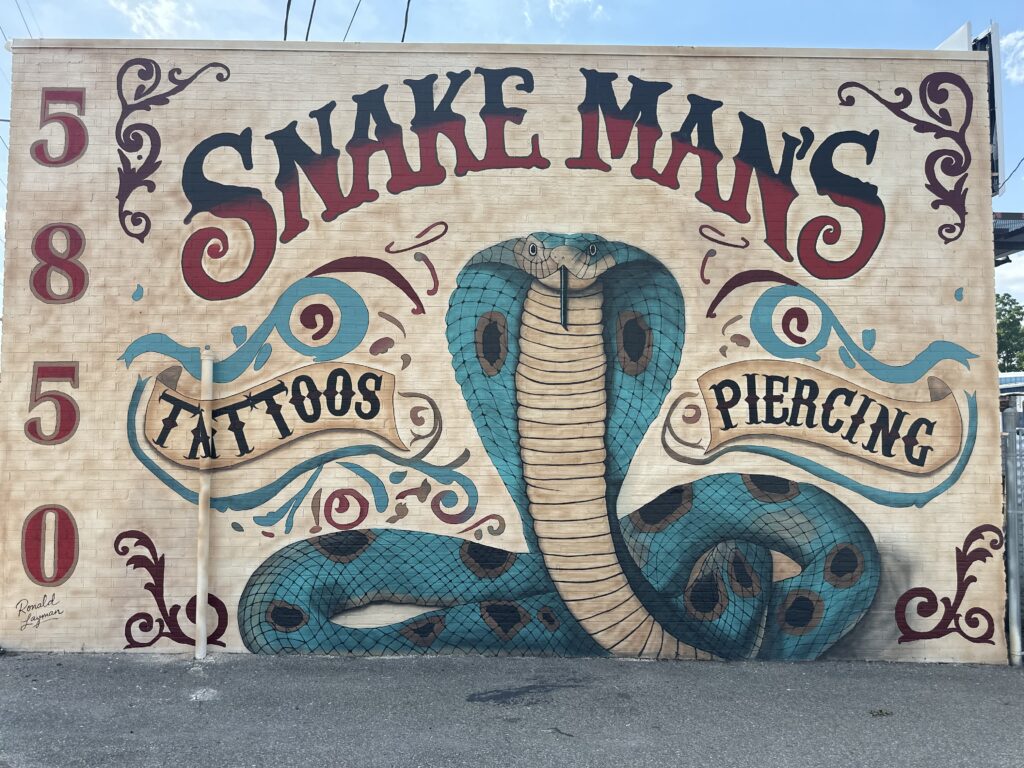
The Story Behind the Snake Man’s Mural
In October 2024, while driving down U.S. 355 in Frederick, Maryland, I passed by a building I’d seen countless times—Snake Man’s Tattoo & Piercing. The white brick wall on the side of the building had long been weathered by time. Its banner was faded, the surface dull, and the space overall lacked presence despite the shop’s strong local identity.That particular day, the potential of that wall stood out in a new way. I didn’t just see a blank wall—I saw a canvas.
After developing a series of sketches and rendering a concept inspired by traditional sideshow and carnival art, I returned to the shop to introduce myself to the owner, Steve—known to many as “Snake Man.” I shared the mural concept and told him: “I’d love to paint this on the side of your building—and it won’t cost you a penny.” He was intrigued and asked how that would work. I explained that I’ve cultivated international network across various social platforms—including Facebook, TikTok, Instagram, Clapper, and video platforms such asYoutube, Bilibili (China) and RUUBE (Russia). This following allows me to attract sponsors and advertisers who fund my public art projects in exchange for exposure. As a result, I’m able to create professionally executed murals at no cost to the property owner—adding value, visibility, and beauty to previously overlooked spaces.
The mural took approximately five and a half weeks to complete—though not for lack of effort. We experienced unusually persistent rain throughout the project. During that entire stretch, there wasn’t a single week where I had three consecutive dry days. I often had to work in between storms, setting up early in the morning, pausing during the rain, and returning to finish details whenever the weather allowed.
This project wouldn’t have been possible without help from some outstanding partners: Rentals Unlimited, Valspar paint and Lowe’s Home Improvenent Co.
This mural is especially important to me because it marks the first exterior mural that I’ve both designed and painted entirely myself. Previous outdoor murals I’ve completed were based on designs created by others. With this project, I wanted something original—something rooted in history, but entirely fresh. My inspiration came from the carnival and sideshow banners of the early 1900s, the kind that were once seen across American fairgrounds and midways. Some of the most influential artists in this tradition include:
Fred G. Johnson – Often referred to as the “grandfather of sideshow banner art.” Based in Chicago, he worked with the O. Henry Tent & Awning Company. His work was exhibited at the 1933 Chicago World’s Fair, where more than 30 of his banners were featured.
|Snap Wyatt – Known for his highly stylized and streamlined banner figures and dramatic color blocking.
Nieman Eisman – Renowned for his bold anatomical exaggerations and attention-grabbing typography.
Using their visual language—bold serif typography, swirling flourishes, and a limited but powerful color palette—I created a mural that not only reflects the shop’s identity but also pays homage to a rich artistic heritage. Even before the mural was complete, photos of it were shared online. One nearly finished image posted on Facebook alone received over 800 shares and impressions.. Visitors began stopping by to take photos, interact with the art, and experience the energy of the space in a new way. The mural transformed the wall from a forgotten surface into a recognizable landmark—a piece of art that not only reflects Frederick’s creative spirit but brings renewed attention to a longstanding local business.
From here, I’ll move on to my next large-scale mural project in downtown Frederick.
I’ll be traveling around the country looking for new walls to transform. If you spot a building or location that would benefit from a one-of-a-kind hand-painted mural, or restorartion mural or sign let me know. You never know—your town could be next. www.youtube.com/ronaldlayman

